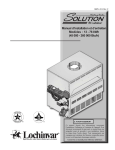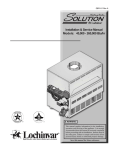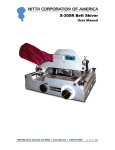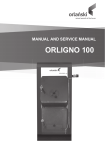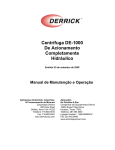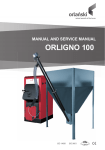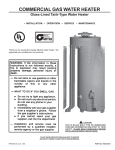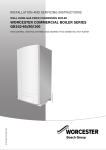Download Lochinvar SOLUTION 260000 User's Manual
Transcript
SBR-I-S Rev B Installation & Service Manual Models: 45,000 - 260,000 Btu/hr WARNING: This manual supplies information for the installation, operation, and servicing of the appliance. It is strongly recommended that this manual be reviewed completely before proceeding with an installation. Perform steps in the order given. Failure to comply could result in severe personal injury, death, or substantial property damage. Save this manual for future reference. Contents HAZARD DEFINITIONS . . . . . . . . . . . . . . . . . . . . . . . . . . 2 PLEASE READ BEFORE PROCEEDING . . . . . . . . . . . . 3-4 RATINGS . . . . . . . . . . . . . . . . . . . . . . . . . . . . . . . . . . . . . . 5 THE SOLUTION --HOW IT WORKS . . . . . . . . . . . . . . . . . . . 6-8 1. DETERMINE BOILER LOCATION Location of Unit . . . . . . . . . . . . . . . . . . . . . . . . . . . . . . . . . 9 Clearances . . . . . . . . . . . . . . . . . . . . . . . . . . . . . . . . . . . . . 9 Combustion and Ventilation Air . . . . . . . . . . . . . . . . . . . 10-12 2. VENTING A Conventional Negative Draft Venting System . . . . . . . 13-14 Vertical Vent Termination Clearances . . . . . . . . . . . . . . . 15 Masonry Chimney Installation . . . . . . . . . . . . . . . . . . . . . 16 Inspection of a Masonry Chimney . . . . . . . . . . . . . . . 16 Automatic Vent Damper . . . . . . . . . . . . . . . . . . . . . . . . . . 17 3. GAS CONNECTIONS Gas Supply . . . . . . . . . . . . . . . . . . . . . . . . . . . . . . . . . . . 18 Gas Pressure Test . . . . . . . . . . . . . . . . . . . . . . . . . . . . . . 18 Gas Connection . . . . . . . . . . . . . . . . . . . . . . . . . . . . . . . . 18 Gas Piping . . . . . . . . . . . . . . . . . . . . . . . . . . . . . . . . . . . . 19 Gas Manifold Pressure Adjustment Procedure . . . . . . . . 20 Checking Gas Supply Pressure . . . . . . . . . . . . . . . . . . . 21 Combination Gas Valves . . . . . . . . . . . . . . . . . . . . . . . . . 22 4. WATER CONNECTIONS Relief Valve . . . . . . . . . . . . . . . . . . . . . . . . . . . . . . . . . . . 23 Water Flow Switch (if equipped) . . . . . . . . . . . . . . . . . . . 23 Low Water Cutoff (if equipped) . . . . . . . . . . . . . . . . . . . . 24 Typical Heating Boiler Installations . . . . . . . . . . . . . . . . . 24-25 Piping of the Boiler System . . . . . . . . . . . . . . . . . . . . . . . 25 Performance Loop . . . . . . . . . . . . . . . . . . . . . . . . . . . . . . 27 Primary/Secondary Boiler Piping . . . . . . . . . . . . . . . . . . . 27-28 Low Temperature Bypass Requirements . . . . . . . . . . . . . 28 Boiler Flow Rates . . . . . . . . . . . . . . . . . . . . . . . . . . . . . . 28 Primary / Secondary Piping . . . . . . . . . . . . . . . . . . . . 29-31 Full System Flow . . . . . . . . . . . . . . . . . . . . . . . . . . . . 32-33 5. ELECTRICAL CONNECTIONS Boiler Operating Temperature Control . . . . . . . . . . . . . . . 34 Room Thermostat or Remote Thermostat Connection . . 34 Auxiliary Device Connection to Terminal Strip . . . . . . . . . 34 Pump Wiring for a Heating Boiler . . . . . . . . . . . . . . . . . . 35 Temperature Adjustment . . . . . . . . . . . . . . . . . . . . . . . . . 35 Temperature Control Settings . . . . . . . . . . . . . . . . . . . . . 35 Maximum Set Point Determination . . . . . . . . . . . . . . . . . 36 Outdoor Air Reset Option . . . . . . . . . . . . . . . . . . . . . . . . 38 Additional Temperature Controls . . . . . . . . . . . . . . . . . . . 38 Blocked Vent and Flame Roll-Out / Flame Interlock Switch . 39 6. STARTUP Initial Startup . . . . . . . . . . . . . . . . . . . . . . . . . . . . . . . . . . 40 Lighting Instructions for Spark Ignition Pilot Models (M9) . . . . 40 Safety Shutoff Test for Spark Ignition Pilot System . . . . . . 41 Intermittent Pilot Spark Ignition System (M9) . . . . . . . . . . . . 42 Freeze Protection . . . . . . . . . . . . . . . . . . . . . . . . . . . . . . . . . . . . . . 42 Water Treatment . . . . . . . . . . . . . . . . . . . . . . . . . . . . . . . . . . . . . . . . 42 7. MAINTENANCE Maintenance and Annual Startup . . . . . . . . . . . . . . . . . . 43-48 8. TROUBLESHOOTING . . . . . . . . . . . . . . . . . . . . . . . . 49 9. DIAGRAMS . . . . . . . . . . . . . . . . . . . . . . . . . . . . . . . . . 50 Hazard definitions The following defined terms are used throughout this manual to bring attention to the presence of hazards of various risk levels or to important information concerning the life of the product. DANGER DANGER indicates an imminently hazardous situation which, if not avoided, will result in death or serious injury. WARNING WARNING indicates a potentially hazardous situation which, if not avoided, could result in death or serious injury. CAUTION indicates a potentially hazardous situation which, if not avoided, may result in minor or moderate CAUTION injury. CAUTION CAUTION used without the safety alert symbol indicates a potentially hazardous situation which, if not avoided, may result in property damage. NOTICE NOTICE indicates special instructions on installation, operation, or maintenance that are important but not related to personal injury or property damage. 2 Installation & Service Manual Please read before proceeding NOTICE This is a gas appliance and should be installed by a licensed electrician and/or certified gas supplier. Service must be performed by a qualified service installer, service agency or the gas supplier. WARNING If the information in these instructions is not followed exactly, a fire or explosion may result causing property damage, personal injury, or death. This appliance MUST NOT be installed in any location where gasoline or flammable vapors are likely to be present, unless the installation is such to eliminate the probable ignition of gasoline or flammable vapors. What to do if you smell gas – • Do not try to light any appliance. • Do not touch any electric switch; do not use any phone in your building. installation, adjustment, WARNING Improper alteration, service or maintenance can result in severe personal injury, death, or substantial property damage. Refer to this manual for assistance or additional information, consult a qualified installer, service agency or the gas supplier. Checking equipment – Upon receiving equipment, check for signs of shipping damage. Pay particular attention to parts accompanying the appliances which may show signs of being hit or otherwise being mishandled. Verify total number of pieces shown on the packing slip with those actually received. In case there is damage or a shortage, immediately notify the carrier. Do not use this appliance if any part has been under water. The possible damage to a flooded appliance can be extensive and present numerous safety hazards. Any appliance that has been under water must be replaced. Owner warning – • Immediately call your gas supplier from a near by phone. Follow the gas supplier’s instructions. NOTE: Retain this manual for future reference. • If you cannot reach your gas supplier, call the fire department. The information contained in this manual is intended for use by qualified professional installers, service technicians, or gas suppliers. Consult your local expert for proper installation or service procedures. Installation and service must be performed by a qualified installer, service agency, or the gas supplier. IMPORTANT Warranty – Installation and service must be performed by a qualified service installer, service agency or the gas supplier. Factory warranty (shipped with unit) does not apply to units improperly installed or improperly operated. Experience has shown that improper installation or system design, rather than faulty equipment, is the cause of most operating problems. 1. Excessive water hardness causing a lime/scale build-up in the copper tube is not the fault of the equipment and is not covered under the manufacturer’s warranty (see Water Treatment and Water Chemistry). 2. Excessive pitting and erosion on the inside of the copper tube may be caused by too much water velocity through the tubes and is not covered by the manufacturer’s warranty (see Boiler Flow Rates and Temperature Rise for flow requirements). Consult and follow all local Building and Fire Regulations and other Safety Codes that apply to this installation. Consult your local gas utility company to authorize and inspect all gas and flue connections. Your conventionally vented gas appliance must have a supply of fresh air circulating around it during burner operation for proper gas combustion and proper venting. WARNING Should overheating occur or the gas supply fail to shut off, do not turn off or disconnect the electrical supply to the pump. Instead, shut off the gas supply at a location external to the appliance. 3 Installation & Service Manual Please read before proceeding WARNING To minimize the possibility of serious personal injury, fire, or damage to your appliance, never violate the following safety rules: 1. Boilers are heat producing appliances. To avoid damage or injury, do not store materials against the appliance or the vent-air intake system. Use proper care to avoid unnecessary contact (especially children) with the appliance and vent-air intake components. 2. Never cover your appliance, lean anything against it, store trash or debris near it, stand on it or in any way block the flow of fresh air to your appliance. 3. UNDER NO CIRCUMSTANCES must flammable materials such as gasoline or paint thinner be used or stored in the vicinity of this appliance, vent-air intake system or any location from which fumes could reach the appliance or vent-air intake system. Codes – The equipment shall be installed in accordance with those installation regulations in force in the local area where the installation is to be made. These regulations shall be carefully followed in all cases. Authorities having jurisdiction shall be consulted before installations are made. In the absence of such requirements, the installation shall conform to the latest edition of the National Fuel Gas Code, ANSI Z223.1. Where required by the authority having jurisdiction, the installation must conform to American Society of Mechanical Engineers Safety Code for Controls and Safety Devices for Automatically Fired Boilers, ASME CSD-1. All boilers conform to the latest edition of the ASME Boiler and Pressure Vessel Code, Section IV. Where required by the authority having jurisdiction, the installation must comply with the Canadian Association Code, CAN/CGAB149.1 and/or B149.2 and/or local codes. This appliance meets the safe lighting performance criteria with the gas manifold and control assembly provided as specified in the ANSI standards for gas-fired appliances, ANSI Z21.13 and ANSI Z21.10.3. 4 Installation & Service Manual Ratings Solution Boiler I=B=R Rating Input MBH Model Number Note: Change “N” to “L” for L.P. gas models. Other Specifications Gross Output MBH Net I=B=R Ratings Water, MBH (Note 1,5) (Note 1,5) (Note 4) Boiler Water Content Gallons Water Connections Vent Gas Connections Size Min Max CBN045 23 45 37 32 0.87 1 1/2" 1/2" 4" CBN075 38 75 62 54 0.91 1 1/2" 1/2" 5" CBN090 45 90 75 65 0.91 1 1/2" 1/2" 5" CBN135 68 135 112 97 0.95 1 1/2" 1/2" 6" CBN180 90 180 149 130 0.99 1 1/2" 3/4" 7" CBN215 108 215 178 155 1.02 1 1/2" 3/4" 7" CBN260 130 260 216 188 1.06 2" 3/4" 8" NOTICE (Note 3) Maximum allowed working pressure is located on the rating plate. Notes: 1. The ratings are based on standard test procedures prescribed by the United States Department of Energy. 2. Net I=B=R ratings are based on net installed radiation of sufficient quantity for the requirements of the building and nothing need be added for normal piping and pickup. Ratings are based on a piping and pickup allowance of 1.15. UNIT EQUIPPED FOR HIGH ALTITUDE UP TO 2000 FT. 3. Use only the vent materials and methods specified in the Installation and Service Manual. 4. The Solution is orificed for operation up to 2000 feet altitude. The appliance will be derated 4% per 1000 feet above 2000 feet elevation. Consult the factory for installations above 2000 feet elevation. Figure A High Altitude Label Location 5. Ratings have been confirmed by the Hydronics Institute, Section of AHRI. 5 Installation & Service Manual The Solution - How it works... 1. Control panel cover The control panel cover provides access to the thermostat, ignition module, and transformer. 2. Burner (not shown) The burner is a cylindrical stainless steel tube used to regulate burner flame. 3. Drain port Location from which the heat exchanger can be drained. 4. Flue outlet The flue outlet allows the connection of the vent pipe to the unit. 5. Gas connection The gas pipe connection on this appliance is 1/2", or 3/4" NPT. To deliver the correct amount of gas volume to the appliance it may be necessary to have a larger gas line reduced at the appliance. Please reference the National Fuel Gas Code charts for more details. 16. Sight Glass The sight glass provides a view of the burner surface, burner flame, and the pilot flame. 17. Temperature and pressure gauge The temperature and pressure gauge monitors the outlet temperature of the appliance as well as the system water pressure. 18. Temperature sensor This sensor monitors inlet water temperature. If selected as the controlling sensor, the appliance will maintain the setpoint at this sensor. 19. Terminal strip The boiler is equipped with a terminal strip on the left side of the unit to allow easy connection to contact points. 20. Top panel Removable panel to gain access to the internal components. 6. Gas valve The gas valve allows the proper amount of gas to pass into the burner for combustion. 7. 8. Heat exchanger The thermostat monitors the water temperature via a temperature sensor and will initiate a call for heat when the water temperature drops below the setpoint plus the differential on the thermostat. The heat exchanger allows system water to flow through specially designed tubes for maximum heat transfer. The glass lined headers and copper finned tubing are encased in a jacket that contains the combustion process. 22. Transformer High limit sensor 23. Water inlet (system return) Device that monitors the outlet water temperature to ensure safe operation. If the temperature exceeds its setting, it will break the control circuit, shutting the appliance down. 9. 21. Thermostat Ignition module The ignition module responds to a call for heat signal to provide burner operation. 10. Junction box The junction box contains the connection points for the line voltage power and all pumps. 11. Performance loop A pumped bypass provides constant flow through the heat exchanger when the building system flow is reduced. 12. Performance Loop Pump The pump ensures adequate flow to operate the unit. 13. Pilot (not shown) The pilot is a spark ignition device used to light a pilot flame which in turn is used to light the main burners. 14. Pump relay The pump relay energizes the pump on a call for heat. 15. Relief valve The relief valve is a safety device that ensures the maximum pressure of the appliance is not exceeded. 6 The transformer reduces 120 VAC supply voltage to 24 VAC for the control circuit. The water inlet is a 1 1/2" pipe connection that receives water from the system and delivers it to the heat exchanger. 24. Water outlet (system supply) The water outlet is a 1 1/2" pipe connection that supplies water to the system with connections for a flow switch, a relief valve, and a temperature and pressure gauge. 25. Gas manifold pipe Delivers gas from the gas valve to the main burners through a number of orifices. Installation & Service Manual The Solution - How it works... (continued) 4 10 20 17 15 1 8 3 5 19 Models 45,000 - 90,000 Btu/hr Front View Models 45,000 - 90,000 Rear View 7 22 18 21 12 9 6 11 23 25 24 14 16 Models 45,000 - 90,000 Right Side (inside unit) Models 45,000 - 90,000 Left Side (inside unit) 7 Installation & Service Manual The Solution - How it works... 10 4 20 17 15 1 8 3 19 5 Models 135,000 - 260,000 Btu/hr Front View Models 135,000 - 260,000 Btu/hr Rear View 7 9 18 12 3 6 3 11 21 25 23 24 22 14 Models 135,000 - 260,000 Btu/hr Right Side (inside unit) 8 Models 135,000 - 260,000 Btu/hr Left Side (inside unit) Installation & Service Manual 1 Determine boiler location Location of unit 1. Locate the appliance so that if water connections should leak, water damage will not occur. When such locations cannot be avoided, it is recommended that a suitable drain pan, adequately drained, be installed under the appliance. The pan must not restrict combustion air flow. Under no circumstances is the manufacturer to be held responsible for water damage in connection with this appliance, or any of its components. 2. The appliance must be installed indoors where it is protected from exposure to wind, rain and weather. Recommended Service Clearances: Left - 24” Front - 24” 14" TOP 3. The appliance must be installed so that the ignition system components are protected from water (dripping, spraying, rain, etc.,) during appliance operation and service (circulator replacement, control replacement, etc.,). 6 " RIGHT 6 " REAR 4. Appliances located in a residential garage and in adjacent spaces that open to the garage and are not part of the living space of a dwelling unit must be installed so that all burners and burner ignition devices have a minimum clearance of not less than 18" (46cm) above the floor. The appliance must be located or protected so that it is not subject to physical damage by a moving vehicle. 18 " LEFT 18 " FRONT Figure 1-1_Alcove Installation - Models 45,000 180,000 Btu/hr Recommended Service Clearances: Left - 24” Front - 24” 5. DO NOT install this appliance in any location where gasoline or flammable vapors are likely to be present. 6. All units have been approved for alcove installation (an ALCOVE is a closet enclosure without a front door). 7. The appliance must not be installed on carpet. 8. All units have been approved for use on combustible surfaces. 29" TOP 9. Allow sufficient space for servicing pipe connections, pump and other auxiliary equipment, as well as the appliance. NOTICE Clearances from combustible construction are noted on the appliance rating plate. 6 " RIGHT 6 " REAR 18 " FRONT 18 " LEFT Figure 1-2_Alcove Installation - Models 215,000 260,000 Btu/hr 9 Installation & Service Manual 1 Determine boiler location Combustion and ventilation air requirements for conventionally vented appliances Provisions for combustion and ventilation air must be in accordance with, Air for Combustion and Ventilation, of the latest edition of the National Fuel Gas Code, ANSI Z223.1, in Canada, the latest edition of CGA Standard B149 Installation Code for Gas Burning Appliances and Equipment, or applicable provisions of the local building codes. The room where the appliance is installed MUST be provided with properly sized openings to assure adequate combustion air and proper ventilation when the appliance is installed with conventional venting. Figure 1-4_Combustion Air Through Ducts 2. If combustion and ventilation air is taken from the outdoors using a duct to deliver the air to the room where the appliance is installed, each of the two openings should be sized based on a minimum free area of one square inch per 2000 Btu/hr (11cm2 per kW) (see FIG. 1-4). Figure 1-3_Combustion Air Direct from Outside 1. If air is taken directly from outside the building with no duct, provide two permanent openings (see FIG. 1-3): (a) Combustion air opening, with a minimum free area of one square inch per 4000 Btu/hr input (5.5 cm2 per kW). This opening must be located within 12" (30 cm) of the floor. (b) Ventilation air opening, with a minimum free area of one square inch per 4000 Btu/hr input (5.5 cm2 per kW). This opening must be located within 12" (30 cm) of the ceiling. 10 Figure 1-5_Combustion Air from Interior Space 3. If air is taken from another interior space that is adequately ventilated, each of the two openings specified above should have a net free area of one square inch for each 1000 Btu/hr (22cm2 per kW) of input, but not less than 100 square inches (645cm2) (see FIG. 1-5). Installation & Service Manual 1 Determine boiler location (continued) CAUTION Figure 1-6_Combustion Air from Outside Single Opening 4. If a single combustion air opening is provided to bring combustion air in directly from the outdoors, the opening must be sized based on a minimum free area of one square inch per 3000 Btu/hr (7 cm2 per kW). This opening must be located within 12" (30 cm) of the top of the enclosure (see FIG. 1-6). Combustion air requirements are based on the latest edition of the National Fuel Gas Code, ANSI Z223.1, in Canada refer to National Standard CAN B149.1. Check all local code requirements for combustion air. All dimensions are based on net free area in square inches. Metal louvers or screens reduce the free area of a combustion air opening a minimum of approximately 25%. Check with louver manufacturers for exact net free area of louvers. Where two openings are provided, one must be within 12" (30 cm) of the ceiling and one must be within 12" (30 cm) of the floor of the room where the appliance is installed. Each opening must have a net free area as specified in Table 1B (on page 12). Single openings shall be located within 12" (30 cm) of the ceiling. Under no circumstances should the room where the appliance is installed ever be under a negative pressure. Particular care should be taken where exhaust fans, attic fans, clothes dryers, compressors, air handling units, etc., may take away air from the appliance. The combustion air supply must be completely free of any flammable vapors that may ignite or chemical fumes which may be corrosive to the appliance. Common corrosive chemical fumes which must be avoided are fluorocarbons and other halogenated compounds, most commonly present as refrigerants or solvents, such as freon, tricholorethylene, perchlorethylene, chlorine, etc. These chemicals, when burned, form acids which quickly attack the heat exchanger finned tubes, headers, flue collectors, and the vent system. The result is improper combustion and a non-warrantable, premature appliance failure. The result is improper combustion and a non-warrantable, premature appliance failure. EXHAUST FANS: Any fan or equipment which exhausts air from the equipment room may deplete the combustion air supply and/or cause a downdraft in the venting system. Spillage of flue products from the venting system into an occupied living space can cause a very hazardous condition that must be immediately corrected. If a fan is used to supply combustion air to the equipment room, the installer must make sure that it does not cause drafts which could lead to nuisance operational problems with the appliance. 11 Installation & Service Manual 1 Determine boiler location TABLE - 1B MINIMUM RECOMMENDED COMBUSTION AIR SUPPLY TO EQUIPMENT ROOM Input Btu/hr *Outside Air from 2 Openings Directly from Outdoors Top Opening, in2 Bottom Opening, in2 45,000 12 (78 cm2) 12 (78 cm2) 75,000 19 (123 cm2) 90,000 *Outside Air from 1 Opening Directly from Outdoors, in2 *Outside Air from 2 Ducts Delivered from Outdoors **Inside Air from 2 Ducts Delivered from Interior Space Top Opening, in2 Bottom Opening, in2 Top Opening, in2 Bottom Opening, in2 15 (97 cm2) 23 (149 cm2) 23 (149 cm2) 100 (646 cm2) 100 (646 cm2) 19 (123 cm2) 25 (162 cm2) 38 (246 cm2) 38 (246 cm2) 100 (646 cm2) 100 (646 cm2) 23 (148 cm2) 23 (148 cm2) 30 (194 cm2) 45 (291 cm2) 45 (291 cm2) 100 (646 cm2) 100 (646 cm2) 135,000 34 (220 cm2) 34 (220 cm2) 45 (291 cm2) 68 (439 cm2) 68 (439 cm2) 135 (871 cm2) 135 (871 cm2) 180,000 45 (291 cm2) 45 (291 cm2) 60 (388 cm2) 90 (581 cm2) 90 (581 cm2) 180 (1,162 cm2) 180 (1,162 cm2) 215,000 54 (349 cm2) 54 (349 cm2) 72 (465 cm2) 108 (697 cm2) 108 (697 cm2) 215 (1,388 cm2) 215 (1,388 cm2) 260,000 65 (420 cm2) 65 (420 cm2) 87 (562 cm2) 130 (839 cm2) 130 (839 cm2) 260 (1,678 cm2) 260 (1,678 cm2) *Outside air openings shall directly communicate with the outdoors. When combustion air is drawn from the outside through a duct, the net free area of each of the two openings must have twice (2 times) the free area required for Outside Air/2 Openings. The above requirements are for the boiler only; additional gas fired appliances in the equipment room will require an increase in the net free area to supply adequate combustion air for all appliances. **Combined interior space must be 50 cubic feet per 1,000 Btu/hr input. Buildings MUST NOT be of *“Tight Construction”. For buildings of *“Tight Construction”, provide air openings into the building from outside. *No combustion air openings are needed when the water heater is installed in a space with a volume NO LESS than 50 cubic feet per 1,000 Btu/hr of all installed gas fired appliances. Buildings MUST NOT be of *“Tight Construction”. *”Tight Construction” is defined as a building with less than 0.40 ACH (air changes per hour). Vent installations for connection to gas vents or chimneys must be in accordance with “Venting of Equipment,” of the latest edition of the National Fuel Gas Code, ANSI Z223.1, in Canada, the latest edition of CGA Standard B149 Installation Code for Gas Burning Appliances and Equipment or applicable provisions of the local building codes. Adequate combustion and ventilation air must be supplied to the room where the appliance is installed in accordance with the latest edition of the National Fuel Gas Code, ANSI Z223.1, in Canada, the latest edition of CGA Standard B149 Installation Code for Gas Burning Appliances and Equipment, or applicable provisions of the local building codes. 12 The distance of the vent terminal from adjacent buildings, windows that open and building openings MUST comply with the latest edition of the National Fuel Gas Code, ANSI Z223.1, in Canada, the latest edition of CGA Standard B149 Installation Code for Gas Burning Appliances and Equipment. Vent connection is made directly to the top of the appliance. This appliance is designed with a built-in draft diverter. No additional external draft hood is required. The connection from the appliance vent to the common vent or chimney must be made as direct as possible. Installation & Service Manual 2 Venting A Conventional Negative Draft Venting System The negative draft in a conventional vent installation must be within the range of a negative 0.02 to 0.05 inches water column to ensure proper operation. All draft readings are made while the appliance is in stable operation (approximately 2 to 5 minutes). Multiple appliance installations with combined venting or common venting with other negative draft appliances require that each appliance must have draft within the proper range. If the draft measured above the appliance’s built-in draft diverter exceeds the specified range in a dedicated chimney for a single appliance installation or in combined venting with other negative draft appliances, a barometric damper must be installed to control draft. TABLE - 2A VENT PIPE SIZES Input Btu/hr Flue Size 45,000 4" 75,000 5" 90,000 5" 135,000 6" 180,000 7" 215,000 7" 260,000 8" On a conventionally vented, negative draft appliance, the connection from the vent to the chimney or vent termination on the outside of the building MUST be made with listed Type “B” double wall (or equivalent) vent connectors and must be direct as possible with no reduction in diameter. Use the National Fuel Gas Code venting tables for double wall vent to properly size all vent connectors and stacks. The Type “B” vent and accessories, such as firestop spacers, thimbles, caps, etc., MUST be installed in accordance with the manufacturer’s listing. The vent connector and firestop must provide correct spacing to combustible surfaces and seal to the vent connector on the upper and lower sides of each floor or ceiling through which the vent connector passes. Any vent materials used must be listed by a nationally Figure 2-1_Conventional Negative Draft Vertical Venting recognized test agency for use as vent material. 13 Installation & Service Manual 2 Venting Locate appliance as close as possible to a chimney or gas vent. Avoid long horizontal runs of the vent pipe, 90° elbows, reductions and restrictions. Horizontal portions of the venting system shall be supported to prevent sagging. Horizontal runs must slope upwards not less than 1/4 inch per foot (21 mm/m) from the appliance to the vent terminal. Follow manufacturer’s instructions. Do not use an existing chimney as a raceway for a flue pipe if another appliance or fireplace is vented through the chimney. The weight of the venting system must not rest on the appliance. Adequate support of the venting system must be provided in compliance with local codes and other applicable codes. All connections should be secured with rustproof sheet metal screws. Vent connectors serving appliances vented by natural draft shall not be connected to any portion of a mechanical draft system operating under positive pressure. Connection to a positive pressure chimney may cause flue products to be discharged into the living space causing serious health injury. Common venting systems may be too large when an existing appliance is removed. At the time of removal of an existing appliance, the following steps shall be followed with each appliance remaining connected to the common venting system placed in operation, while other appliances remaining connected to the common venting system are not in operation. (a) Seal any unused opening in the common venting system. (b) Visually inspect the venting system for proper size and horizontal pitch and determine there is no blockage or restriction, leakage, corrosion and other deficiencies which could cause an unsafe condition. (c) Insofar as is practical, close all building doors and windows and all doors between the space in which the appliances remaining connected to the common venting system are located and other spaces of the building. Turn on clothes dryers and any other appliances not connected to the common venting system. Turn on any exhaust fans, such as range hoods and bathroom exhausts, so they will operate at maximum speed. Do not operate a summer exhaust fan. Close fireplace dampers. (d) Place in operation the appliance being inspected. Follow the lighting instructions. Adjust thermostat so appliance will operate continuously. 14 (e) Test for spillage at the draft hood/relief opening after 5 minutes of main burner operation. Use the flame of a match or candle, or smoke from a cigarette, cigar or pipe. (f) After it has been determined that each appliance remaining connected to the common venting system properly vents when tested as outlined above, return doors, windows, exhaust fans, fireplace dampers and other gas burning appliances to their previous conditions of use. (g) Any improper operation of the common venting system should be corrected so that the installation conforms to the latest edition of the National Fuel Gas Code, ANSI Z223.1. In Canada, the latest edition of CGA Standard B149 Installation Code for Gas Burning Appliances and Equipment. When resizing any portion of the common venting system, the common venting system should be resized to approach the minimum size as determined using the appropriate tables in Part 11 in the latest edition of the National Fuel Gas Code, ANSI Z223.1. In Canada, the latest edition of CGA Standard B149 Installation Code for Gas Burning Appliances and Equipment. Installation & Service Manual 2 Venting (continued) Vertical Vent Termination Clearances 10' OR LESS 10' OR LESS 10' OR LESS CHIMNEY 2' MIN 2' MIN 3' MIN 2' MIN 3' MIN RIDGE CHIMMEY Figure 2-2_Vent Termination from Peaked Roof 10' or Less from Ridge WALL OR PARAPET CHIMMEY Figure 2-4_Vent Termination from Flat Roof 10' or Less from Parapet Wall 10' OR MORE MORE THAN 10' 3' 10' 2' MIN CHIMNEY RIDGE 3' MIN NOTE: NO HEIGHT ABOVE PARAPET REQUIRED WHEN DISTANCE FROM WALLS OR PARAPETS IS MORE THAN 10'. WALL OR PARAPET CHIMNEY Figure 2-3_Vent Termination from Peaked Roof More than 10' from Ridge Figure 2-5_Vent Termination from Flat Roof More Than 10' from Parapet Wall T





















































